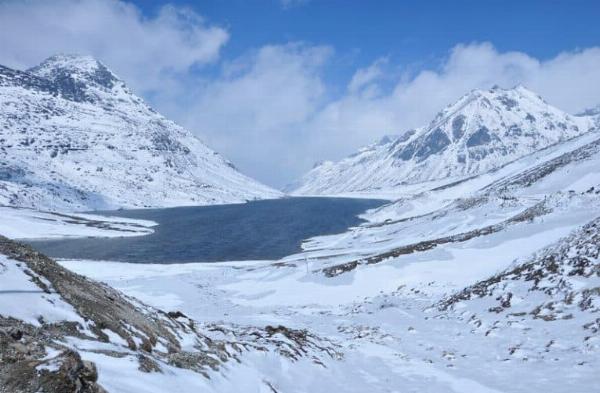Understanding the Sela Pass Temperature: A Comprehensive Guide

Strong 8k brings an ultra-HD IPTV experience to your living room and your pocket.
The Sela Pass, situated in Arunachal Pradesh, India, is one of the most stunning and significant high-altitude passes in the Eastern Himalayas. Connecting the town of Tawang with the rest of Arunachal Pradesh, this pass offers not only breathtaking views but also a unique climate that can be both challenging and fascinating. In this article, we'll explore the Sela Pass temperature, weather patterns and what you can expect when visiting this remarkable location.
Introduction to Sela Pass
The Sela Pass, also spelled as "Sela" or "Se-la," is located at an altitude of approximately 4,170 meters (13,681 feet) above sea level. This high mountain pass lies on the border of Tawang district in Arunachal Pradesh and is a vital route for travelers moving between Tawang and the rest of Arunachal Pradesh. The pass is renowned for its picturesque landscapes, including serene lakes and snow-capped peaks, making it a popular destination for both adventure enthusiasts and nature lovers.
Sela Pass Temperature Overview
The Sela Pass temperature varies significantly depending on the season and time of day. Due to its high elevation, temperatures can drop sharply, especially during the winter months. Here's a breakdown of what you can generally expect throughout the year:
Winter (November to February): Winters at Sela Pass are cold and harsh. During this period, temperatures can plummet to as low as -10°C (14°F) or even lower, especially at night. Daytime temperatures are still quite chilly, often hovering between -5°C (23°F) and 5°C (41°F). Snowfall is common during these months, transforming the pass into a winter wonderland. Roads can be icy and treacherous, so travelers should be prepared for extreme weather conditions.
Spring (March to May): Spring brings a gradual warming trend to Sela Pass. Temperatures during this season range from 5°C (41°F) to 15°C (59°F). Snow begins to melt, revealing the lush greenery and vibrant flowers that bloom around the pass. The weather is generally more stable, making it a good time for travel and exploration.
Summer (June to August): Summers at Sela Pass are relatively mild but can still be quite cool due to the altitude. Daytime temperatures typically range from 15°C (59°F) to 20°C (68°F), while nighttime temperatures can drop to around 10°C (50°F). This period is marked by occasional rain showers and thunderstorms, which can make the roads slippery and foggy.
Autumn (September to October): Autumn is another favorable time to visit Sela Pass. Temperatures range from 10°C (50°F) to 15°C (59°F) during the day, while nights can be quite chilly, dropping to around 5°C (41°F). The weather is generally dry and clear, providing excellent visibility and pleasant conditions for travel and sightseeing.
Sela Pass Weather and Its Impact on Travel
The Sela Pass weather can have a significant impact on travel plans. Due to the high altitude and extreme temperatures, it is essential to prepare adequately before making the journey. Here are some key points to consider:
Road Conditions: The road leading to Sela Pass can be challenging, especially during winter and the monsoon season. Snow and ice can make the roads slippery, and landslides may occur during heavy rainfall. It is crucial to check road conditions before traveling and consider hiring a local guide or driver familiar with the area.
Clothing and Gear: Depending on the time of year, you’ll need appropriate clothing and gear. In winter, pack heavy-duty winter clothing, including thermal wear, insulated jackets, gloves, and boots. For other seasons, layered clothing is advisable to adapt to changing temperatures. It’s also wise to bring rain gear and high-quality sunglasses to protect against strong sunlight and glare from snow.
Health Precautions: High altitudes can affect your health, particularly if you’re not acclimatized. Symptoms of altitude sickness include headaches, dizziness, and shortness of breath. It’s important to acclimatize gradually, stay hydrated, and avoid overexertion. If you experience severe symptoms, seek medical attention promptly.
Tourism and Attractions at Sela Pass
Despite the challenging weather conditions, Sela Pass is a popular destination due to its stunning natural beauty and unique attractions. Some of the highlights include:
Sela Lake: Also known as "Sela Lake" or "Paradise Lake," this beautiful glacial lake is situated near the pass. Surrounded by snow-capped peaks, it offers a serene and picturesque setting. The lake is a favorite spot for photography and peaceful reflection.
Breathtaking Views: The pass offers panoramic views of the surrounding mountains and valleys. On clear days, you can see distant peaks and lush landscapes that create a mesmerizing backdrop.
Biodiversity: The region around Sela Pass is rich in biodiversity. You may encounter various species of flora and fauna adapted to the high-altitude environment. Keep an eye out for unique Himalayan wildlife and vibrant alpine flowers.
Tips for Visiting Sela Pass
Check Weather Conditions: Always check the weather forecast and road conditions before your trip. The weather can change rapidly, so be prepared for sudden shifts in conditions.
Travel Permits: If you're traveling to Sela Pass, ensure you have the necessary permits. Foreign tourists may require special permissions to visit this restricted area.
Health and Safety: Acclimatize properly to the altitude and be prepared for sudden weather changes. Carry a first-aid kit and necessary medications for altitude sickness.
Local Guidance: Consider hiring a local guide or driver who is experienced with the route. They can provide valuable insights and ensure a safer journey.
Conclusion
The Sela Pass is a remarkable destination with its extreme temperatures and stunning views. Understanding the Sela Pass temperature and weather patterns will help you plan a safer and more enjoyable trip. Whether you’re an adventure seeker or simply looking to appreciate the natural beauty of Arunachal Pradesh, Sela Pass offers a unique and unforgettable experience. With proper preparation and respect for the environment, you can make the most of your visit to this majestic high-altitude pass.
Note: IndiBlogHub features both user-submitted and editorial content. We do not verify third-party contributions. Read our Disclaimer and Privacy Policyfor details.


